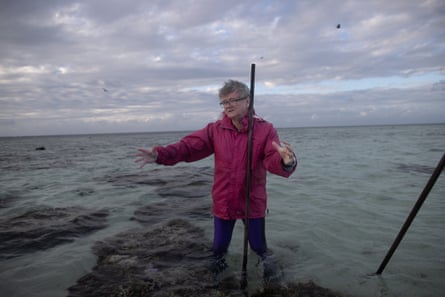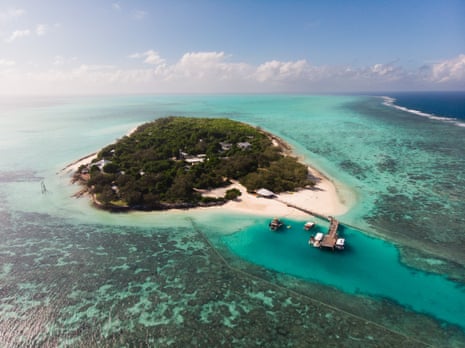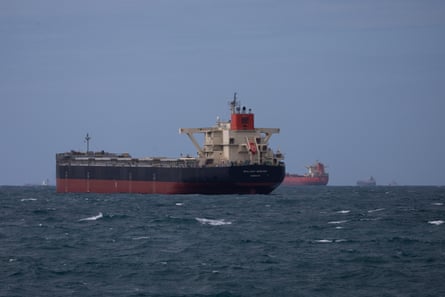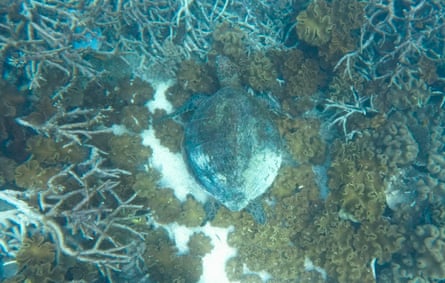Extract from The Guardian
Scientists stunned by scale of destruction after summer of storm surges, cyclones and floods
Wed 1 May 2024 01.00 AEST
Last modified on Wed 1 May 2024 01.41 AESTBeneath the turquoise waters off Heron Island lies a huge, brain-shaped Porites coral that, in health, would be a rude shade of purplish-brown. Today that coral outcrop, or bommie, shines snow white.
Prof Terry Hughes, a coral bleaching expert at James Cook University, estimates this living boulder is at least 300 years old.
“If that thing had eyes it could have looked up and watched Captain Cook sail past,” he says, back on the pristine beach of this speck of an island 80km offshore at the southern end of the Great Barrier Reef.
It is not just Heron’s grand old bommie that is freshly bleached. The surrounding tangle of staghorn corals, or Acropora, are splashed in swathes of white, or painted a dappled mosaic of greens and browns that betray the algae and seaweeds growing over the freshly killed coral. Hughes estimates 90% of those branching corals are dead or dying.

Snorkelling above these blighted coral thickets evokes the imagery of forests annihilated by bushfires, or cities obliterated by missiles.
“It looks as if it has been carpet bombed,” says the Greens senator Peter Whish-Wilson, who has accompanied Hughes to Heron. “Like limbs strewn everywhere.”
Even Hughes, a man who has witnessed as much mass mortality of coral as any, looks shellshocked.
The Dublin-born, Townsville-based marine biologist already knew the coral ringing Heron had just experienced its worst recorded bleaching – and that this was no isolated event.
It’s fucking awful … it’s a graveyard out there
Last month the Australian Institute of Marine Science and the Great Barrier Reef Marine Park Authority released a report warning that the reef was experiencing “the highest levels of thermal stress on record”. The authority’s chief scientist, Dr Roger Beeden, spoke of extensive and uniform bleaching across the southern reefs, which had dodged the worst of much of the previous four mass bleaching events to blight the Great Barrier Reef since 2016.
Hughes saw in the institute’s aerial surveys results the most “widespread event and severe” bleaching event to date, not just in the south, but across much of the entire system – which stretches 2,300km up the Queensland coast.
But none of these metrics, it seems, could truly prepare him for the act of bearing witness to the unfolding calamity he has dedicated his life to preventing.
“It’s fucking awful,” the softly spoken scientist says, emerging from the ocean. “They said the bleaching was extensive and uniform. They didn’t say it was extensive, uniform and fucking awful.
“It’s a graveyard out there.”


Lethal hot water
The academic director of the University of Queensland research station on Heron, Dr Selina Ward, doesn’t mince words either. She describes this as “the year from hell”.
Storm surges washed away some of her favourite stands of corals, there have been outbreaks of coral-eating crown-of-thorns starfish, cyclones and floods. But these “multiple assaults” pale compared with this most “horrendous bleaching”.
The bleaching peaked in February and March. At the end of March, Ward visited 16 sites around Heron and nearby reefs, including around One Tree Island – a scientific reserve with “the maximum level of protection you can get”.
“It was terrible, the worst bleaching event I’ve ever seen,” she says. “In those 16 sites, every single one was severely bleached – and some of the corals were starting to die already.”
Her big question, though, is what is happening under the water right now.
Corals bleach when sustained exposure to warmer than average water causes them to expel the photosynthetic algae that give them colour – and from which the corals polyps obtain much of their nutrients.
A coral can die or recover from bleaching. The weeks that follow a bleaching event are a brief window in which scientists like Ward and Hughes can assess how many corals have starved without their symbiotic algae. In a few months, those newly dead corals will be covered in weed and beginning to be broken down into barren rubble piles – the time and cause of their demise will become more and more obscured.
The reef is now in that window, Ward says, where scientists can get into the water and observe the amount of bleached corals that – though left more vulnerable to disease and less fertile – might just regain colour and pull through. As well as those that will not.
But bleaching is only one coral reaction to what Hughes says is perhaps better described as a hot water event. Some corals will simply “cook”. Others turn a vivid blue or neon yellow – a garish shade our research vessel’s skipper says has been widespread on the corals around Heron.
These, though dazzling, are also disconcerting – this fluorescence is a protein corals produce as a kind of sunscreen. It is not a very effective defence though. According to Hughes, most of these neon corals won’t survive.
“The irony is that it looks beautiful in death,” Whish-Wilson says of a fluorescent coral while he and Hughes wade through knee-deep water as the tide recedes around Heron and coral tips emerge from the water like bones.

The unseen national emergency
A hulking and rusty bow is slowly revealed as a bulk carrier connected, by crane-like loaders, to great mounds of crushed black earth. Behind it, another ship is being loaded with coal. And another behind that.
Then, as the catamaran rounds Curtis Island, it ducks and weaves its way through bulk carrier after bulk carrier, lurking outside the harbour like a school of sharks at the edge of a reef. On his phone’s shipping app, Hughes lists 43 of the steel leviathans.

Whish-Wilson says the flotilla speaks to a government having “a bet each way”.
“But you can’t have a future for fossil fuels and a future for a healthy reef,” he says. “You just can’t.”
Later, reflecting on a trip he already feels will haunt the rest of his life, the Greens healthy oceans spokesperson says this devastating bleaching should trigger Unesco to declare the Great Barrier Reef’s world heritage values as “in danger” and demand a visit from the federal environment minister, as well as a declaration of national emergency.
If this were a bushfire raging across thousands of kilometres, he says, that declaration would already have been made.
“But because it is in the ocean, it is out of mind, out of sight.”
Slim hope of recovery
Another of Heron’s incongruities is that, even amid such underwater devastation, it still harbours breathtaking beauty. Green sea turtles cruise above stands of broken coral, giant coral trout open their mouths and gills for electric blue cleaner wrasse, manta rays glide gracefully through the shallows.
Hughes first came here as a postdoctoral researcher in 1985 and has often returned. Now, as he prepares to leave Heron once more, he ponders the future of a natural wonder of the world to which he has given so much of his life.

The 67-year-old has seen the coral ecosystems of the Great Barrier Reef degrade and knows that they are on the inexorable path of further decline. Yet, if global heating can be limited to well below 2C on pre-industrial levels, Hughes still believes it is possible to stabilise sea temperatures and allow those corals that survive to mount a slow recovery.
It is not a question of hope or resignation, he says, but “immediate action”.
Unless fossil fuel emissions are cut “ASAP”, he says, the corals of the world’s reefs will be replaced by something else, perhaps seaweed or sponges.
“There would still be a tropical ecosystem here,” Hughes says with a sweep of his hand. “But at some point we would have to say it is no longer a coral reef. We’d have to call it something else.”
So when will Hughes return to Heron to see what, if anything, recovers? Will he check on that grand old bommie, now snow white?
“I’m not sure I will come back,” he says.

And why not? To this, a long pause, as Hughes looks away and out at the ocean, the only sound a choked sob and the haunting wail of the black noddies that brood and swarm on this troubled coral cay.
“’Cause it’s so upsetting,” he says, eventually.
Not that Hughes plans on staying silent.
“I think scientists like me need to be as vocal as possible,” he says. “To show people what’s happening.”
No comments:
Post a Comment